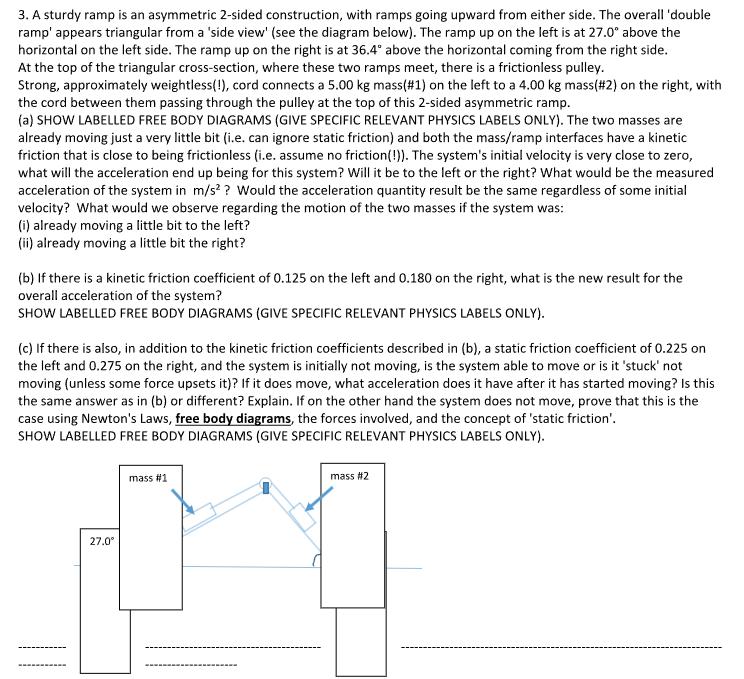Answered step by step
Verified Expert Solution
Question
1 Approved Answer
3. A sturdy ramp is an asymmetric 2-sided construction, with ramps going upward from either side. The overall 'double ramp' appears triangular from a

3. A sturdy ramp is an asymmetric 2-sided construction, with ramps going upward from either side. The overall 'double ramp' appears triangular from a 'side view' (see the diagram below). The ramp up on the left is at 27.0 above the horizontal on the left side. The ramp up on the right is at 36.4 above the horizontal coming from the right side. At the top of the triangular cross-section, where these two ramps meet, there is a frictionless pulley. Strong, approximately weightless(!), cord connects a 5.00 kg mass (#1) on the left to a 4.00 kg mass (#2) on the right, with the cord between them passing through the pulley at the top of this 2-sided asymmetric ramp. (a) SHOW LABELLED FREE BODY DIAGRAMS (GIVE SPECIFIC RELEVANT PHYSICS LABELS ONLY). The two masses are already moving just a very little bit (i.e. can ignore static friction) and both the mass/ramp interfaces have a kinetic friction that is close to being frictionless (i.e. assume no friction(!)). The system's initial velocity is very close to zero, what will the acceleration end up being for this system? Will it be to the left or the right? What would be the measured acceleration of the system in m/s? Would the acceleration quantity result be the same regardless of some initial velocity? What would we observe regarding the motion of the two masses if the system was: (i) already moving a little bit to the left? (ii) already moving a little bit the right? (b) If there is a kinetic friction coefficient of 0.125 on the left and 0.180 on the right, what is the new result for the overall acceleration of the system? SHOW LABELLED FREE BODY DIAGRAMS (GIVE SPECIFIC RELEVANT PHYSICS LABELS ONLY). (c) If there is also, in addition to the kinetic friction coefficients described in (b), a static friction coefficient of 0.225 on the left and 0.275 on the right, and the system is initially not moving, is the system able to move or is it 'stuck' not moving (unless some force upsets it)? If it does move, what acceleration does it have after it has started moving? Is this the same answer as in (b) or different? Explain. If on the other hand the system does not move, prove that this is the case using Newton's Laws, free body diagrams, the forces involved, and the concept of 'static friction'. SHOW LABELLED FREE BODY DIAGRAMS (GIVE SPECIFIC RELEVANT PHYSICS LABELS ONLY). mass #1 mass #2 27.0
Step by Step Solution
★★★★★
3.56 Rating (156 Votes )
There are 3 Steps involved in it
Step: 1

Get Instant Access to Expert-Tailored Solutions
See step-by-step solutions with expert insights and AI powered tools for academic success
Step: 2

Step: 3

Ace Your Homework with AI
Get the answers you need in no time with our AI-driven, step-by-step assistance
Get Started


